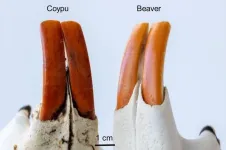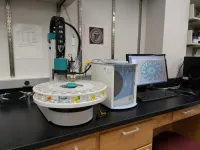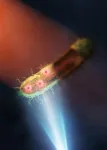(Press-News.org) Researchers at Weill Cornell Medicine have developed a powerful, new technique to generate “movies” of changing protein structures and speeds of up to 50 frames per second.
Senior author, Dr. Simon Scheuring, the Distinguished Professor of Anesthesiology Research at Weill Cornell Medicine and colleagues developed the new approach to gain a better understanding of how biological molecules change structurally over time. Although investigators in this field routinely image static proteins and other molecules finely enough to resolve the positions of individual atoms, the resulting structural pictures or models are snapshots. Recording the dynamics of molecular structures—making movies—has been a much harder challenge. The lead author of the study is Yining Jiang, a doctoral candidate in the Weill Cornell Graduate School of Biomedical Sciences.
In their study, published April 17 in Nature Structural & Molecular Biology, the researchers used a relatively new measurement technique called high-speed atomic-force microscopy (HS-AFM), which employs an extremely sensitive probe to scan across molecules’ surfaces, essentially feeling their structures. As a key innovation, the scientists found a method to isolate their target molecule, a single protein, thus avoiding effects from protein-to-protein interactions and enabling faster and more precise scanning.
The researchers applied their new single-molecule HS-AFM approach to a protein called GltPh, a “transporter” that sits in the cell membrane, directing neurotransmitter molecules into the cell. Such transporters are among the favorite targets of structural biologists due to their complex and puzzling dynamics, and their importance in health and disease.
The researchers obtained dynamic structural data on GltPh with an unprecedented combination of high spatial and time resolution—and stability, so that they could record tiny fluctuations in GltPh’s structure continuously for minutes. An unsolved phenomenon in such proteins was termed ‘wanderlust’ kinetics, meaning that molecules were reported to functionally change between high and low activity modes, for no obvious reason. The work revealed a previously unseen structural state of GltPh, in which the transporter is locked and functionally asleep, uncovering the basis of ‘wanderlust’ kinetics.
The researchers emphasized that their new approach, which they are continually trying to optimize, is generalizable for studying other proteins, including membrane-embedded proteins. Overall, they said, this work opens up new possibilities to track the precise structure of a protein moment-by-moment during its cycles of activity and rest.
This research was supported by the National Institute of Health (NIH), National Center for Complementary and Integrative Health, grant DP1AT010874, and the National Institute of Neurological Disorders and Stroke, R01NS110790.
Many Weill Cornell Medicine physicians and scientists maintain relationships and collaborate with external organizations to foster scientific innovation and provide expert guidance. The institution makes these disclosures public to ensure transparency. For this information, please see the profile for Dr. Scheuring.
END
Tracking a protein’s fleeting shape changes
2024-04-17
ELSE PRESS RELEASES FROM THIS DATE:
Study finds iron-rich enamel protects, but doesn’t color, rodents’ orange-brown incisors
2024-04-17
Chattering squirrels, charming coypus, and tail-slapping beavers — along with some other rodents — have orange-brown front teeth. Researchers have published high-resolution images of rodent incisors in ACS Nano, providing an atomic-level view of the teeth’s ingenious enamel and its coating. They discovered tiny pockets of iron-rich materials in the enamel that form a protective shield for the teeth but, importantly, don’t contribute to the orange-brown hue — new insights that could improve human dentistry.
Human and animal teeth are coated in a ...
Continuing efforts are addressing health disparities among Hispanic Latino people in U.S.
2024-04-17
DALLAS, April 17, 2024 — Language barriers, longstanding structural racism barriers, underrepresentation within the ranks of health care professionals and higher than average rates of poor health risk factors are among the alarming trends that continue to impede quality health care outcomes for Hispanic Latino people living in the United States. The American Heart Association, celebrating 100 years of lifesaving service as the world’s leading nonprofit organization focused on heart and brain health for all, is making strides ...
CHEST and APCCMPD announce recipient of collaborative fellow scholarship
2024-04-17
Glenview, Illinois – Esha Kapania, MD, will be the mentee for the inaugural year of the 2024 APCCMPD and CHEST Medical Educator Scholar Diversity Fellowship.
Designed to pair a fellow-in-training with an established medical educator, the unique scholarship was launched in August by the American College of Chest Physicians (CHEST) and the Association of Pulmonary and Critical Care Medicine Program Directors (APCCMPD) to improve diversity in pulmonary and critical care medical education.
The program focuses ...
E-tongue can detect white wine spoilage before humans can
2024-04-17
PULLMAN, Wash. – While the electronic tongue bears little physical resemblance to its namesake, the strand-like sensory probes of the “e-tongue” still outperformed human senses when detecting contaminated wine in a recent study.
In an experiment at Washington State University, the e-tongue identified signs of microorganisms in white wine within a week after contamination—four weeks before a human panel noticed the change in aroma. This was also before those microbes could be grown from the wine in a petri-dish. Winemakers traditionally rely on these two methods, sniffing the wine and petri-dish testing, to ...
Adults with congenital heart disease faced higher risk of abnormal heart rhythms
2024-04-17
Research Highlights:
Almost 1 in 5 adults with congenital heart disease living in Israel had or developed an abnormal heart rhythm over five years.
Adults with congenital heart disease who developed an irregular heart rhythm in the heart’s upper chambers faced a 65% increased risk of premature death.
The adults who developed an irregular heart rhythm in the heart’s lower chambers had double the risk of premature death.
Embargoed until 4 a.m. CT/5 a.m. ET Wednesday, April 17, 2024
DALLAS, April 17, 2024 — Almost 1 in 5 adults with congenital heart disease living in Israel had or developed an abnormal ...
A better view with new mid-infrared nanoscopy
2024-04-17
A team at the University of Tokyo have constructed an improved mid-infrared microscope, enabling them to see the structures inside living bacteria at the nanometer scale. Mid-infrared microscopy is typically limited by its low resolution, especially when compared to other microscopy techniques. This latest development produced images at 120 nanometers, which the researchers say is a thirtyfold improvement on the resolution of typical mid-infrared microscopes. Being able to view samples more clearly at this smaller scale can aid multiple fields of research, including into infectious diseases, and opens the way for developing ...
New study uncovers why boys born to mothers with HIV are at greater risk of health problems and death in infancy
2024-04-17
Researchers have found that children of women with HIV infection have an increased risk of immune abnormalities following exposure to maternal HIV viraemia, immune dysfunction, and co-infections during pregnancy.
The study, led by Dr Ceri Evans while at Queen Mary University of London, compared clinical outcomes between infants who were HIV-exposed and HIV-unexposed in the Sanitation Hygiene Infant Nutrition Efficacy (SHINE) trial in rural Zimbabwe. Despite high coverage of maternal antiretroviral therapy (ART) and uptake of exclusive breastfeeding, mortality in infants exposed to HIV was 41% higher than in infants not exposed to HIV. Infants who survived and remained HIV-free ...
Interspecies competition led to even more forms of ancient human – defying evolutionary trends in vertebrates
2024-04-17
Competition between species played a major role in the rise and fall of hominins – and produced a “bizarre” evolutionary pattern for the Homo lineage – according to a new University of Cambridge study that revises the start and end dates for many of our early ancestors.
Conventionally, climate is held responsible for the emergence and extinction of hominin species. In most vertebrates, however, interspecies competition is known to play an important role.
Now, research shows for the first time that competition was fundamental to “speciation” – the rate at which new species emerge ...
First new analysis in three decades identifies which treatments for the long-term effects of malnutrition could help reduce mortality and poor health outcomes for children
2024-04-17
A comparison of treatments for malnutrition enteropathy, caused by severe acute malnutrition (SAM), has found evidence supporting the use of treatments to enhance the healing of mucosal membranes and reduce inflammation in the gut to improve the outcomes of children affected by long-team health consequences of a period of malnutrition.
The Therapeutic Approaches to Malnutrition Enteropathy (TAME), led by researchers from Queen Mary University of London, evaluated four interventions for malnutrition enteropathy in a multi-centre phase ...
AI speeds up drug design for Parkinson’s by ten-fold
2024-04-17
Researchers have used artificial intelligence techniques to massively accelerate the search for Parkinson’s disease treatments.
The researchers, from the University of Cambridge, designed and used an AI-based strategy to identify compounds that block the clumping, or aggregation, of alpha-synuclein, the protein that characterises Parkinson’s.
The team used machine learning techniques to quickly screen a chemical library containing millions of entries, and identified five highly potent compounds for further investigation.
Parkinson’s affects more than six million people worldwide, with that number projected to triple by 2040. ...



